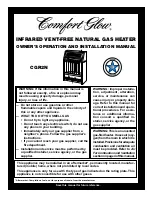
48
Servicing should only be performed by a Qualified Service Agent
On System applications, each Burner Control is represented on the Home page by an icon and name. Pressing the icon allows the
user to zoom in on that burner and see its specific details. These details are provided on a new page, which can include additional
buttons that display additional detail and operation information, which itself leads to other pages. The pages are traversed in a tree
structure method, as shown in Figure 31 on Page 47.
The Control System icons will appear in one of four colors indicating the boiler/water heater status.
• Blue: Normal operation
• Red: Lockout condition
• Gray: Communication error (disconnected or powered off)
• Yellow: Holding mode
Up to 8 Systems can be displayed on the Home page. The name of each burner is displayed next to the Control System icon button.
When Lead Lag is enabled, the system header temperature and firing rate are displayed for each System. When the burner is in
standby or not firing the firing rate is not displayed.
Note: The boiler/water heater name may be cut off on the Home page when all icons are present.
The Home page also includes buttons for Lead Lag configuration when lead lag master and slave in the Burner control is enabled.
Pressing the Setup button on the Home page displays miscellaneous setup and diagnostic functions. It also contains the setup
configuration for BAS applications.
The “Control snapshot” button allows the user to dump the current status and/or configuration settings of any Burner controller into
a text document. The text document can be viewed on the display, saved to flash for later viewing, and can be written to a USB stick
for viewing on a PC or file transfer. Pressing the Burner control icon opens that control’s status page. Go to “Configure” button to
continue.
PAGE NAVIGATION
The Burner Control OI Displays present information and options in a paged manner. Pages are displayed in a tree structure in
which the user navigates up and down to arrive at the desired Function. The page descriptions are provided below so that you can
understand the purpose of each and view the selections, parameters, and information that is available or required on each.
COMMON OI DISPLAY PAGE SYMBOLS
Most pages have a Home button in the top-left corner of the screen and a Back button in the top-right corner of the screen. The
Home button returns the user to the Home page and terminates any operation in progress. The Back button returns the user to the
previous page.
Two other icons may be noticed near the boiler/water heater name.
A camera button is for screen snapshot use. Up to 16 snapshots can be stored in the display and can be copied to a USB memory
stick.
A padlock indicates the operator is not currently logged in (may have been timed out) and a password is needed to change the
setting. An unlocked padlock indicates the password has been entered and the operator has logged into system successfully.
STATUS OR HOME PAGE
A status (summary) page (Figure 32 on Page 49) is displayed when the S7999D display is connected. This status page appears
on the S7999D when the Burner Control icon is pressed on the “Home” page. The status page displays the current condition of the
burner control and displays some of the more important configuration settings.
The initial status page displayed contains summary status information as shown in Figure 32 on Page 49. Any status information not
applicable for the installation is grayed/blanked out on the screen.
Buttons on this screen include:
• Configure:
used to configure the burner control (password protected and all pre-configured).
•
Operation:
used to perform daily or frequent functions with the burner control, such as setpoint adjustment, etc.
• Diagnostic:
used to view burner control diagnostic information (for servicing and temperature setting purpose only).
• Details:
used to view burner control detail status information.
• History:
used to view burner control history.
• Pump:
used to expand the pump status information.
• Modulation:
used to toggle between status displays: pump, setpoints, and modulation.
Summary of Contents for 100 Series
Page 2: ...2 Servicing should only be performed by a Qualified Service Agent...
Page 77: ...77 Servicing should only be performed by a Qualified Service Agent NOTES...
Page 78: ...78 Servicing should only be performed by a Qualified Service Agent NOTES...
Page 79: ...79 Servicing should only be performed by a Qualified Service Agent NOTES...
















































